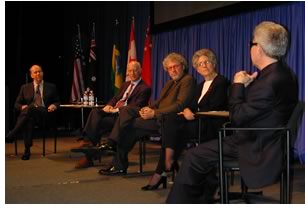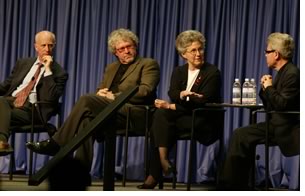

Getting Real in Lower
Manhattan
Panel debates whether Libeskind’s
design can survive intact
 Following
Daniel Libeskind’s stirring presentation May 10 of his team’s
proposal for the World Trade Center site, a panel at the AIA national
convention in San Diego, including Libeskind, turned its attention to
how the proposal would fare in the real world.
Following
Daniel Libeskind’s stirring presentation May 10 of his team’s
proposal for the World Trade Center site, a panel at the AIA national
convention in San Diego, including Libeskind, turned its attention to
how the proposal would fare in the real world.
“We’ve seen the vision,” said moderator Robert Ivy, FAIA, editor in chief of Architectural Record on May 10 at the closing general session. “Now let’s get to the reality.”
The winning team “doesn’t have a client in the conventional sense,” pointed out Paul Goldberger, Hon. AIA, architecture critic for The New Yorker. Crediting typical New York attitude, “[Office developer] Larry Silverstein of Silverstein Properties tried, but that was not going to happen,” he said.
Instead, he listed the governors of New York and New Jersey, the mayor of New York City, Silverstein, retail developer Westfield America, the Port Authority, the Lower Manhattan Development Corp., the victims’ families, the business community, and the citizens as just a sampling of those watching the process.
“One thing I see happening is that Daniel will perform a mediating role,” he said. “We’re blessed that we have an architect who is gifted as a spokesman. He will create political strength and credibility for the design.”
“The issue is to have Daniel stay with it through its iterations,” added Stanton Eckstut, FAIA, founding principal of Ehrenkrantz, Eckstut & Kuhn and consultant to the Port Authority during the competition. Later in the program, he worried that most architects are not trained well to speak to the public as Libeskind can.
 Eckstut
outlined four objectives that were put forth to influence thinking during
the competition: the exercise was not about buildings, but about building
a city; it needed to rely on precedents; strong emphasis must be on creating
public places; and the resulting designs had to have a clear path for
development. “Most ambitious projects die because no one knows where
to begin,” Eckstut said.
Eckstut
outlined four objectives that were put forth to influence thinking during
the competition: the exercise was not about buildings, but about building
a city; it needed to rely on precedents; strong emphasis must be on creating
public places; and the resulting designs had to have a clear path for
development. “Most ambitious projects die because no one knows where
to begin,” Eckstut said.
Frances Halsband, FAIA, founding partner of New York City’s R.M. Kliment & Frances Halsband Architects, reminded the audience that the original business credentials outlined for participating architects precluded Libeskind. It was only the public rejection of the earlier proposals that allowed him to get involved and address the more conceptual needs.
Given the environment in which the design was presented, Halsband credited the Libeskind proposal for its directness. “When Jumbotron is watching, you need ideas of incredible simplicity so everyone can get them, even the press,” she said, getting an inadvertent laugh at Goldberger’s expense. Nonetheless, she cautioned that elements such as the 1,776-foot-tall tower and the “Wedge of Light” may not be doable in the long run. The “Wedge” concept proposes to provide full solar illumination in a V-shaped public space between 8:46 a.m., when the first plane hit, and 10:28 a.m., when the second tower fell. It’s been widely and publicly debated as not possible.
Libeskind said he will show that it is, but he also celebrated the fact that it was an issue at all. “For the first time in thousands of years,” he speculated, “people are talking about two angles of light.”
Copyright 2003 The American Institute of Architects.
All rights reserved. Home Page ![]()
![]()
 |
||
|
|
||